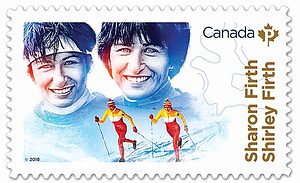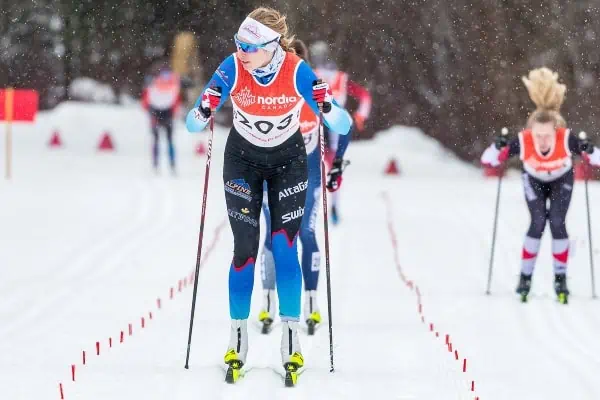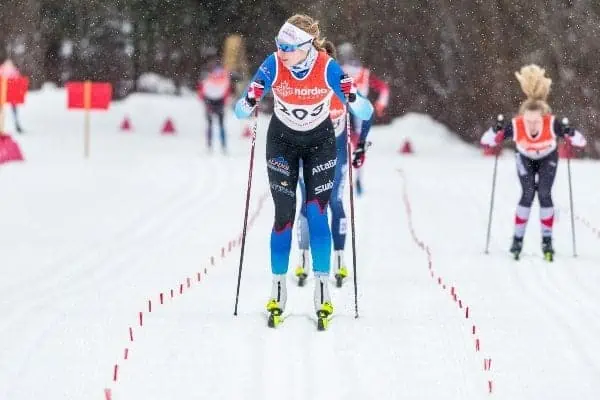
One winter morning in the early 1970s, I picked up an airport-bound passenger with my taxi from the now-defunct Eskimo Inn in Inuvik. After a little small talk, he asked me why there were so many young foreigners in the hotel lobby. “Cross country skiers,” I replied. “Where are they from?” he asked. “Finland, Sweden, a whole bunch of countries,” I said. With a skeptical look, he asked, “what the hell are they doing here?”
A priest’s passion for sport and twin athletes’ championship pedigree make history in the Mackenzie Delta.
“They’ve come to race the best skiers in North America,” I said.
With the airport only a few miles away, I had to give him a shortened version of how a group of northern cross country skiers from Inuvik (who were practically children) were dominating the skiing world in North America. At the time, it would have been nice to see into the future. I would have told that fella that a couple of those scrawny kids would replace the queen on a postage stamp a few decades later. That would have blown his mind.
The genesis of the Arctic juggernaut began when the recreation coordinator of the N.W.T. heard about a successful cross country ski program, developed by Father Jean Mouchet in Old Crow, Yukon. After Father Mouchet was invited to come to Inuvik to run a few successful ski clinics, the territorial and federal governments funded the Territorial Experimental Ski Training (TEST) program. Recruitment of top athletic talent, along with a transplanted Norwegian coach named Bjorger Petterson, fell into place in the 60s.
Father Mouchet recruited nearly 200 eager young students into the TEST program. It was still a time when the coaching staff didn’t have to worry about outside distractions from television and other electronic devices. Inuvik already had a ton of addiction problems due to alcohol and drugs, but luckily for most of the young’uns of TEST, they were getting addicted to the ski trails. Most of today’s teens would consider the daily training grind cruel and unusual punishment. There was regular weight training at the Canadian Forces gym a few times a week. Training on the ski trails was relentless for many hours, every day of the week. The young trainees had to ski 200 kilometres on army skis before they could graduate to racing skis. For many reasons, their enthusiasm never faltered.
Skiing was a much better alternative than the humdrum of regular Inuvik life. There were a few kids getting away from some deep, dark secrets of residential school. Many sat in their classrooms like excited children on Christmas morning, daydreaming about what Coach had told them—if you practice hard, you might get good enough to travel to the outside world. As they got closer to traveling to their first competition in Anchorage, Alaska, the training intensified. It was becoming the norm to do 30-kilometre circuits in temperatures that dropped into the range of -30 degrees C.
Coach Petterson was extremely happy with his young charges. Maybe they wouldn’t look out of place in Anchorage, he thought. He knew his kids had been only skiing for a little over a year. They would be competing against skiers who had years of experience and many competitions under their belt. A team of 21 skiers would make the trip to Anchorage. Although only a few of the skiers had perfect technique with smooth, fluid strides, their training had turned them all into a mentally tough and gritty bunch.
The tough training produced two rising stars, the Firth sisters—Shirley and Sharon. The twins came into the program as an unintended package deal. When an excited, wide-eyed Shirley Firth asked her mother, Fanny, for permission to join the ski team, she approved with one caveat. Shirley had to take her sister with her. Fanny never realized that her decision would change the course of women’s cross country skiing in North America for the next 15 years. The twins’ competitors would discover Fanny’s decision the hard way. The only thing they ever saw of the twins on the ski trails (please tolerate the pun) were their fannies.
For the kids of the far north, Anchorage seemed to be a huge city. The place had a smorgasbord of distractions to digest. They were totally fascinated when they saw an escalator for the first time. However, these distractions never hindered their performance on the ski trails. Even though the trails were sheets of ice and the temperature was 25 degrees warmer than Inuvik, their training had taught them to fight through any obstacle that got in their way. After the first day of racing, Anchorage thought they had been engulfed by an Arctic tornado.
On the first race of the day, Fred Kelly led the boys to victory. He wasn’t lonely either. Three of his teammates made up the top five. The junior girls turned the place upside down. Shirley Firth won her first of many gold medals in her career. She and her teammates swept the first five places. There were 15 possible medals up for grabs in Anchorage. Eleven found a new home in Inuvik. American champion, Barbara Britch, was one of few who could compete with the Arctic bandits. She had barely managed to squeeze out a victory. Her day of reckoning was coming. When the skiers returned to Inuvik, they began to prepare for the Western Division Championships in Prince George, B.C. Coach Petterson switched the training tempo from distance to speed.
On their first morning in Prince George, the young athletes discovered a new novelty. They were flabbergasted when they spotted images on a color TV screen in a department store. A bewildered sales clerk stared at them, unaware that it was the first time that they had seen a television. The northern speedsters ran over the southern competition. They had to make do with competing with themselves. After Prince George, an intense short sprint training regime was put in place to increase heart and lung capacity. Their next big meet would be the Canadian Junior Championships in Thunder Bay, Ontario.
Ten Inuvik racers headed to Thunder Bay for their first test against the nation’s best, who were older and more experienced. One of Yogi Berra’s quotes is apt to describe the Thunder Bay race results—it’s like deja vu all over again. A shocked crowd watched Fred Kelly, just 16 at the time, snatch the Canadian Junior Championship out of the hands of Olympic prospect, 19-year-old Malcolm Hunter. The only difference from Anchorage was that the Tundra Twins had to settle for silver and bronze medals, and hold the spotlight for their teammate and new Canadian champion, 13-year-old Roseanne Allen. The young skier’s spectacular achievements started to ripple through the media.
After their stunning success, the Canadian Ski Association invited them to represent Canada at the U.S. Championships in Montana. Bridger Bowl, 6,000 feet above sea level, presented a new challenge for the young Arctic upstarts. They were used to skiing on the edge of the Mackenzie delta, which was barely above sea level. Fortunately for the Americans, they didn’t have to tangle with Fred Kelly because of an injury. For the girls, it would be a rematch with the American champion, Barbara Britch. The local’s first impressions exuded confidence that the pint-sized northerners were no match for their champion. The tension built when the girl’s junior event got started. It was the competition that most racing fans were waiting for. A stunned home crowd watched the northern girls claim three of the four top spots. One skier towered above them all.
Standing four-feet-11-inches tall and tipping the scales at 94 lbs, 14-year-old Shirley Firth was the champion of North America. None of their school daydreams had ever featured an interview with Time magazine. Inuvik greeted the team with a hero’s welcome and a noticeable change could be seen after their championship year. Confidence replaced shyness when they spoke. Young northerners, and especially Aboriginals, finally had someone to emulate. From the beginning, Coach Petterson’s target was the 1976 Olympics. After their success, his new goal would be Sapporo, Japan, in 1972. Eight skiers would represent Canada in 1972 and five would be from Inuvik. Not too shabby for a town of 2,800 people.
Now that they were Canada’s team, the team moved south to train. The Olympics didn’t bode well for the northern skiers. Shirley Firth, weakened from a bout of hepatitis, managed to finish 34th. The rest of the skiers had better results, but didn’t finish near the medals. They could have trained until they dropped dead and they still would have missed the mark. Their opponents of the Eastern Bloc played by a different rulebook. By the mid 70s, TEST was on shaky ground. Government programs usually always followed the same pattern. They can’t stand prosperity and start to fiddle with the funding. One by one, the skiers started to leave the program until there were only two.
The twins had always been in a league of their own. Year after year, they kept vacuuming up the medals and awards. They would eventually represent Canada at four Olympics and despite never medalling at the games, being from the Gwich’in Nation, they were among Canada’s first Indigenous athletes on the Olympic stage.
After more than a decade-and-a-half, the sisters packed it in. Sharon was the last to retire, a few months after her sister. She finished her last race the same way she and her double had started—with a victory. They had paved the way for future Canadian Olympians Becky Scott and Chandra Crawford. As for some of the Canadian ski officials, I bet they dreaded hearing one of Joni Mitchell’s hit songs. Those lyrics probably just kept ricocheting and echoing inside their minds.
“You don’t know what you’ve got till it’s gone!”



